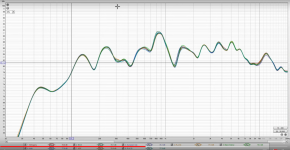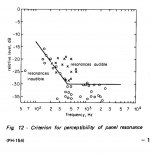Since I use Baltic birch plywood for my enclosures, it's good to see it scores higher than commonly used MDF. In my experience birch makes for a slightly more lively sound while MDF tends to darken and slow things down a bit. And from a strictly woodworking standpoint, MDF dust is much finer and it gets everywhere!
Interesting, the speaker response from 45Hz to 20kHz was +/- 9.5 dB, while even including the worst-case no-fill plastic "outlier", the response deviation between all the different materials was less than +/- .75 dB.
I have yet to measure two of the same type drivers that have that little deviation between a pair.
Art
I have yet to measure two of the same type drivers that have that little deviation between a pair.
Art
Attachments
Amen Art
All the discussions that focus on so many nearly inconsequential aspects of DIY,
down so far in SNR or orders of magnitude of importance to SQ,
... aspects that amount to WHO CARES
...like in, what do they have anything to do with how can i realistically make better sound??
...are beginning to make me think i'm nuts for even reading such threads....
Sorry, rant over...
All the discussions that focus on so many nearly inconsequential aspects of DIY,
down so far in SNR or orders of magnitude of importance to SQ,
... aspects that amount to WHO CARES
...like in, what do they have anything to do with how can i realistically make better sound??
...are beginning to make me think i'm nuts for even reading such threads....
Sorry, rant over...
Interesting, the speaker response from 45Hz to 20kHz was +/- 9.5 dB, while even including the worst-case no-fill plastic "outlier", the response deviation between all the different materials was less than +/- .75 dB.
I have yet to measure two of the same type drivers that have that little deviation between a pair.
Art
Yep. Whilst frequency response and its cousin dispersion isn't eveything, it is certainly a considerable thing.
I’m currently revising my speakers and can see and hear the results of response tweaks and then room EQ.
I can’t say the same for any of the cabinet variations I am trying.
They may well measure better, and there is a great thread at HTguide about this. But audibility is swamped by other errors.
In terms of bang for buck, fixing speaker/room interaction should surely come first.
All the discussions that focus on so many nearly inconsequential aspects of DIY,
down so far in SNR or orders of magnitude of importance to SQ,
... aspects that amount to WHO CARES
...like in, what do they have anything to do with how can i realistically make better sound??
...are beginning to make me think i'm nuts for even reading such threads....
I would suggest everyone with an interest in the quality of their speakers should care. Resonant sound from the enclosure may not be a large factor but it is an audible one for many DIY enclosures. Unlike many of the important factors in speaker quality doing something about is straightforward to achieve if the DIYer takes an interest in what is (genuinely) going on and what can be done to improve things.
When I first started speaker DIY in the early 70s everyone I knew would damp their cabinets with car underseal, roofing tar, bitumen or similar. Today DIYers are more likely to stick felt on the walls. It is curious how general knowledge, if that is the right term, has not necessarily improved despite the improvements in communication, measurement, materials, drivers, manufacturing, etc... The video illustrates the point rather nicely.
Every result needs to be extrapolated....The guy even made a super tiny TL that needed no stuffing to achieve flat response (resonance/harmonics too small?)....resonance size is related to enclosure size, tiny enclosure, tiny resonance....the results should be significantly different at the size of a monkey coffin....for example...probably somewhat the same trend but exaggerated
Fair enough Mark, but where to draw the line?
In my humble non-scientific opinion, some things are best kept about 24dB down. This is where they may be contributing around a 0.5dB variation.
Fair as well Allen,
I agree with your call about 24dB down...seems like a good intersection of pragmatism and some realistic hoped for excellence.
Fair enough Mark, but where to draw the line?
In my humble non-scientific opinion, some things are best kept about 24dB down. This is where they may be contributing around a 0.5dB variation.
Why not aim to bring the cabinet sound radiation below the audibility threshold which is under -24 dB at least at midrange frequencies? This is achievable if one follows the physics and has an inaudible level of sound radiation as a goal. It will add complexity, time and cost but will result in genuinely higher quality speakers. I guess we all have our own sets of values but I would always have this as one of my objectives. May not be achievable if in conflict with others like low complexity, cheapness, or whatever but it would still be there pushing to improve the quality of the speakers.
I would suggest everyone with an interest in the quality of their speakers should care. Resonant sound from the enclosure may not be a large factor but it is an audible one for many DIY enclosures. Unlike many of the important factors in speaker quality doing something about is straightforward to achieve if the DIYer takes an interest in what is (genuinely) going on and what can be done to improve things.
When I first started speaker DIY in the early 70s everyone I knew would damp their cabinets with car underseal, roofing tar, bitumen or similar. Today DIYers are more likely to stick felt on the walls. It is curious how general knowledge, if that is the right term, has not necessarily improved despite the improvements in communication, measurement, materials, drivers, manufacturing, etc... The video illustrates the point rather nicely.
Apologize if i stepped on any toes with my "signifigance rant".
Yep, i remember the advice in the 70's to dampen cabinets. It was a bit of a fad it almost it seemed..???
My first build was in the mid to late 60's. I built, at least to my knowledge, perhaps the first large sized boom box.
It had either a 10 or 12 inch full-range driver (can't remember) driven by a mighty 8 watt Ratshack battery powered transistor amp lol.
It was damn nice....used carpet for dampening...but that was more to keep the hidden booze compartment from rattling, haha.
Anyway, yes, i take quality oh so seriously.
It's just i keep experiencing once a certain quality threshold is met from a particular aspect, it's best to withdraw energy and expense from further work on that aspect.
You know, find the weakest link and work on that....let go of the every-aspect perfection-obsession (not always easy for me).
Frankly all the Youtube video did was strengthen my opinion about once thresholds are met, go no further... differences shown were inconsequential imho.
I certainly saw nothing worth pursuing in terms of box material...but then again I've only used baltic birch for the last 30+ speakers I've built.
BBC's view on cabinet resonance audibility
http://downloads.bbc.co.uk/rd/pubs/reports/1977-03.pdf
I've re-read this article a few times and don't really understand 90% of it, but it has one little diagram that did hit home with me (first attachment)
It shows that midrange resonances are easier to hear than bass-range resonances.
They show in the article that lighter panels are easier to dampen which brings the resonances down into the "harder to hear" bass range.
I tried a build with thin walls and lots of damping and it was a fun change from my usual 3/4 ply routine. They are subjectively less resonant when you tap them. And music can't be felt as strongly through the walls. Anyway, I might post some pics here soon.
http://downloads.bbc.co.uk/rd/pubs/reports/1977-03.pdf
I've re-read this article a few times and don't really understand 90% of it, but it has one little diagram that did hit home with me (first attachment)
It shows that midrange resonances are easier to hear than bass-range resonances.
They show in the article that lighter panels are easier to dampen which brings the resonances down into the "harder to hear" bass range.
I tried a build with thin walls and lots of damping and it was a fun change from my usual 3/4 ply routine. They are subjectively less resonant when you tap them. And music can't be felt as strongly through the walls. Anyway, I might post some pics here soon.
Attachments
They show in the article that lighter panels are easier to dampen which brings the resonances down into the "harder to hear" bass range.
Unfortunately it left most BBC monitors with a fattish coloured bass. Most owners like the coloration. Sales of the big Harbeth’s an example.
dave
Which Is Better for Sound?
1st question: Why didn’t he use the factory gasket supplied with the driver? Given the FE166 basket his sealing may be flaky. Given the consitency of the measurements he may have gotten away with it
Don’tknow how much he showed, mostly just looking at damping.
dave
This might be a bit too subjective for many, but apart from the awful attempt at humour at the start, I found it interesting.
Cabinet walls and Loudspeaker Energy Preservation - [English]
Cabinet walls and Loudspeaker Energy Preservation - [English]
....The guy even made a super tiny TL that needed no stuffing to achieve flat response (resonance/harmonics too small?)....resonance size is related to enclosure size, tiny enclosure, tiny resonance....the results should be significantly different at the size of a monkey coffin
This is true...So I have since subscribed to bracing that reflects these thoughts. Dividing the internal volume of a cab, using internal baffles, creates areas of smaller, higher, resonate modes. So even though you end up with multiple smaller resonances...the higher resonant note is less efficient at being excited...at least thats my theory. In general wave theory, higher frequencies transfer at much less efficiency than low. It would be interesting to see this modeled in Akabak.
In a sealed or vented TL...two enclosures with identical volume...one with A=CSA, the other with A/2=CSA....the second iteration will have less resonance.
Last edited:
They show in the article that lighter panels are easier to dampen which brings the resonances down into the "harder to hear" bass range.
That isn't quite right. The BBC's objectives were to design cabinets that were light enough to lug around, straightforward enough to manufacture using the technology familair and available to low-tech speaker manufacturer's of the time and with a performance that was just about good enough to do the job rather than high performance.
What the approach does is exchange a worsened low frequency resonant behaviour in order to gain an improved one at higher frequencies which as your plots shows is audibly more intrusive. They used simple and crude extensional damping in large quantities rather than something with a better performance like CLD which they were aware of but judged too complicated. Ditto for better materials than wood. Sensible engineering compromise for the times that the audiophile fantasy machine seems to have turned into something exotic and magical particularly here in the UK.
A comparison with what 50 years of steadily improving materials, manufacturing capability and design methods has brought to commercial speaker cabinets can be seen in the LS50 white paper.
- Home
- Loudspeakers
- Multi-Way
- Which cabinet material is best. YouTube test

